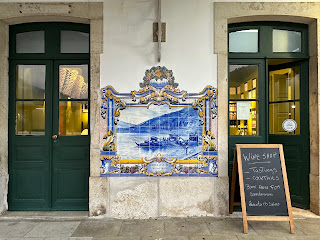Wednesday 24 January 2024
Porto is a big sprawling city, the municipality has a population of 230,000, whereas the wider metropolitan area has in the region of 1.7 million. We’d parked the van on the eastern outskirts, at Fânzeres Park & Ride, to avoid the city traffic and toll roads and to use their cheap and efficient Metro system. We got off the tram at a station called Casa da Música so that Dave could see the Peninsula War Monument.
The description on Wikipedia explains the history of the monument which is dedicated to the heroes of the 1808-1814 Peninsular War. It celebrates the Portuguese and British victory (represented by the lion) against the French forces of Napoleon (represented by the eagle). Around the base are sculptures of soldiers and civilians.
Wikipedia describes it as being in the middle of a busy roundabout set a ‘peaceful’ tree-lined garden. Umm ….. it’s not quite so peaceful at the moment as a completely new metro line (the Pink Line) is being built here and walking out of the underground we were surrounded by noisy pile drivers, diggers, cranes and concrete lorries.
After three weeks of hardly seeing any other tourists, walking around Porto came as a bit of a shock to us. Considering it’s off season there were visitors everywhere which is great for the bars, cafes, hotels, boat trip companies, port & wine tasting businesses etc. but felt really strange for us. We walked around and took in the sights - trying to avoid the tour groups & their guides, the selfie-stick brigade (oblivious to where they were walking), and the hawkers trying to tempt you onto various trips.
It’s a very colourful city and the River Douro and the Dom Luís I Bridge are the main draws for most visitors. The day before we had driven about 90 miles inland up the Douro Valley to the pretty town of Pinhão, in the centre of the wine growing region. The train station at Pinhão, like São Bento in Porto, has some beautiful blue and white tile panels depicting scenes of life in the Douro region.
The Peninsula War Monument was built very slowly between 1909 and 1951 having been delayed by two world wars. Let’s hope the metro lines in Porto are finished in a quicker timeframe!












No comments:
Post a Comment